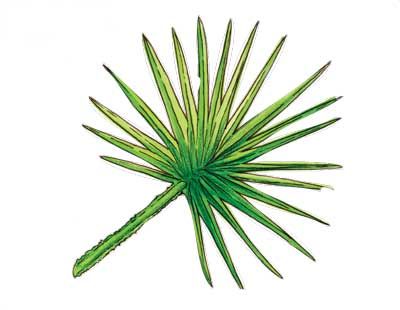Saw Palmetto
Saw palmetto, a small, slow-growing palm, is prevalent in the southeastern United States. Its berries are a rich source of fatty acids and phytosterols, and were used by Native Americans as food and also as medicine to treat urinary tract problems.
Saw palmetto, a small, slow-growing palm, is prevalent in the southeastern United States. Its berries are a rich source of fatty acids and phytosterols, and were used by Native Americans as food and also as medicine to treat urinary tract problems. Saw palmetto is currently used to promote urination, reduce inflammation, and to treat prostatic conditions such as benign prostatic hyperplasia (BPH) and prostate cancer. It is available in the form of dried berries, tablets, capsules, and liposterolic extracts. -Barrie Cassileth, phd
ALSO KNOWN AS: Saw, palmetto berry, American dwarf palm tree, cabbage palm.
RESEARCH: Based on its historic use and laboratory studies, the ability of saw palmetto to improve prostate health has been the subject of many clinical trials, but data are inconclusive. Some studies indicate that it improves urinary flow

rate and reduces nocturia in patients with benign prostatic hyperplasia,[1,2] but other research found no such effects.[3,4] A recent study showed that saw palmetto may benefit patients with chronic bacterial prostatitis when coadministered with Urtica dioica, curcumin, and quercitin.[5] Further re-search is needed to resolve the ambiguity.
Saw palmetto demonstrated anticancer effects in vitro and in animal studies.[6] It also was shown to increase the radiosensitivity of normal prostate cells; interestingly, cancerous cells remained unaffected.[7]
ADVERSE REACTIONS: Although infrequent, saw palmetto may cause nausea, vomiting, gastrointestinal problems, and diarrhea.[8]
A case of severe intraoperative hemorrhage following consumption of saw palmetto has been reported.[8]
Hematuria and coagulopathy were observed in a patient with use of saw palmetto.[9]
HERB-DRUG INTERACTIONS: Anticoagulants: Saw palmetto may have additive anticoagulant effects and can prolong bleeding time.[8]
COMMENTS: The berries of saw palmetto or dwarf palm, native to the southeastern United States, were used by Native Americans as food and as a remedy for urinary tract problems. Today, saw palmetto is extremely popular in both the US and Europe for the treatment of symptoms associated with benign prostatic hyperplasia.
Saw palmetto has been investigated by many groups, but evidence of its efficacy for the treatment of prostatic conditions is mixed. Additional research is needed.
Preclinical data indicate that saw palmetto has anticancer properties. However, a recent study revealed an unexpected preferential increase in radiosensitivity of normal prostate cells over malignant cells in the presence of saw palmetto. Until definitive data are available, prostate cancer patients should avoid saw palmetto supplementation when undergoing radiotherapy.
TAKE HOME POINTS
• The berries of saw palmetto, rich in fatty acids and phytosterols, were used in Native American medicine for urinary tract problems.
• Current evidence for saw palmetto’s effectiveness in treating prostatic conditions is mixed.
• Because saw palmetto can increase the sensitivity of normal prostate cells to radiation, patients with prostate cancer should avoid this supplement during radiotherapy.
For additional information, visit the Memorial Sloan-Kettering Cancer Center Integrative Medicine Service website, “About Herbs,” at http://www.mskcc.org/AboutHerbs.
References:
REFERENCES
1. Shi R, Xie Q, Gang X, et al: Effect of saw palmetto soft gel capsule on lower urinary tract symptoms associated with benign prostatic hyperplasia: A randomized trial in Shanghai, China. J Urol 179:610-615, 2008.
2. Hizli F, Uygur MC: A prospective study of the efficacy of Serenoa repens, tamsulosin, and Serenoa repens plus tamsulosin treatment for patients with benign prostate hyperplasia. Int Urol Nephrol 39:879-886, 2007.
3. Bent S, Kane C, Shinohara K, et al: Saw palmetto for benign prostatic hyperplasia. N Engl J Med 354:557-566, 2006.
4. Tacklind J, MacDonald R, Rutks I, et al: Serenoa repens for benign prostatic hyperplasia. Cochrane Database Syst Rev Apr 15(2):CD001423, 2009.
5. Cai T, Mazzoli S, Bechi A, et al: Serenoa repens associated with Urtica dioica (ProstaMEV) and curcumin and quercitin (FlogMEV) extracts are able to improve the efficacy of prulifloxacin in bacterial prostatitis patients: Results from a prospective randomised study. Int J Antimicrob Agents 33:549-553, 2009.
6. Wadsworth TL, Worstell TR, Greenberg NM, et al: Effects of dietary saw palmetto on the prostate of transgenic adenocarcinoma of the mouse prostate model (TRAMP). Prostate 67:661-673, 2007.
7. Hasan Y, Schoenherr D, Martinez AA, et al: Prostate-specific natural health products (dietary supplements) radiosensitize normal prostate cells. Int J Radiat Oncol Biol Phys 76:896-904, 2010.
8. Cheema P, El-Mefty O, Jazieh AR, et al: Intraoperative haemorrhage associated with the use of extract of saw palmetto herb: A case report and review of literature. J Intern Med 250:167-169, 2001.
9. Villanueva S, González J: Coagulopathy induced by saw palmetto: A case report. Bol Asoc Med P R 101:48-50, 2009.
Newsletter
Stay up to date on recent advances in the multidisciplinary approach to cancer.